MM24 clinical trial – an opportunity for George
Ten months after his diagnosis and having failed standard treatment, George Yiannakis is the first of potentially 12 Australians to go on the international MM24 clinical trial for AL amyloidosis.
“I really feel privileged because I know so many people in my situation don’t have this opportunity,” said George, 56, of Melbourne.
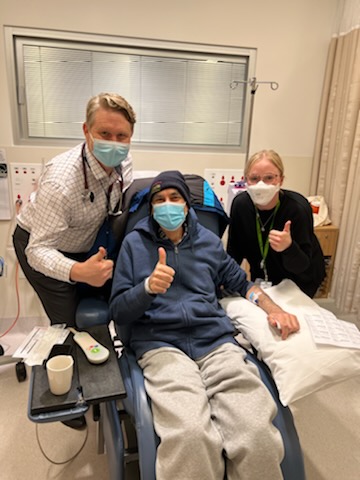
“It’s not often someone has the chance to access medication that has recently been developed.
“It’s something new, it opens new opportunities, and I’m hopeful it will provide me with the response that the standard treatment hasn’t been able to, and that something better will come out of it,” said George.
The MM24 trial is supported by the Leukaemia Foundation through its National Research Program.
It took eight months to get an AL amyloidosis diagnosis
When George heard the words, “I suspect it could be amyloidosis”, eight months after noticing his first symptoms in early-2021, he’d never heard of this rare form of blood cancer.
He and his wife, Patricia, had met in George’s office when they were living in Perth. He’d came to Australia from Cyprus in 2013 “to start a job with the Australian Government” and Patricia had migrated from Colombia earlier that same year.
When George started feeling “inexplicably” tired and lethargic the couple was leading a “very active lifestyle’ in Melbourne’s CBD.
“I’ve never smoked, I don’t remember the last time I had half a glass of alcohol, and our nutrition is excellent. Patricia has always been into organic fruit and veggies, and we would take long walks along the Yarra River and to Fitzroy Park,” said George, who also enjoyed a brisk 20-minute walk on Sunday mornings to his Greek Orthodox Church.
One Sunday morning, George suddenly felt breathless and for the first time found his walk to church difficult.
“I had to take a break, which was so unexpected. I thought, ‘what is going on here?’, so I stopped for about 10-15 minutes to rest halfway, and then continued,” said George.
He’d also begun sleeping up to 11 hours, yet he felt fatigued, weary, and lacking in energy “for no obvious reason”. When he started getting “strange purple blood clots or dots” around his eyes and on his eyelids, Patricia said, ‘George, we really have to get it checkout out’.
They sent photos to a friend (a doctor) who was at Harvard and his response was “this has to be investigated, especially the physical symptoms which are not normal. It could be related to a heart problem”.
George went to see his GP, insisting that he see him face-to-face.
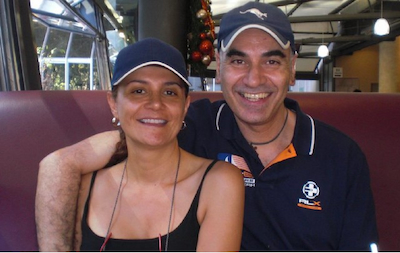
“This was taking place while we were under lockdown, so access to specialists and health services at the time was quite restricted due to the COVID situation,” said George.
“I explained the physical symptoms, my feeling of exhaustion when I got up in the morning to log on to my computer and I showed him my eyes.
“He looked at me bewildered and said, ‘oh, don’t worry. It could be that when you are sleeping you are flapping your arms around and you hit yourself’!
“I didn’t think that was a reasonable explanation and insisted on having the normal run-of-the-mill blood tests which didn’t show much apart from confirming that I have beta thalassemia.
“Things continued as they were, but I was confounded by how I was feeling and I was juggling my job responsibilities,” said George who works for the Australian Government Department of Education where he was accountable for a team that managed childcare programs.
“My nature is to deal with different circumstances and adversity head-on. I really felt that I had to persevere and continue as if things were normal.”
Another GP took on George’s case when his previous doctor moved to another practice.
“Again, I went through the process of explaining how I was feeling, the tiredness and lethargy, and how it was impacting on my energy,” said George.
This GP ordered another set of blood tests which showed an “exceptionally high albumin reading”, which was explained to George in laymen’s terms, saying it could be a statistical anomaly. More tests, a couple of weeks later confirmed the previous result.
“One morning – I remember it was the 6th of August – I logged onto my computer to work from home. I was very pale, my heart was racing, I had a very irregular heartbeat, and my blood pressure was low,” George explained.
When he told Patricia he had “to soldier on”, she said “no”, insisting that he didn’t look well and needed to go to the Emergency department. The nearest hospital was 15 minutes from where they lived and, due to COVID-19 restrictions, Patricia couldn’t escort him inside.
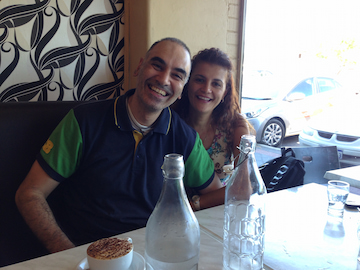
The triage process identified that George had an erratic heartbeat. After some tests including an x-ray and ECG, the hospital doctor said, “George, you’ve got a heart flutter that needs to be investigated”. He was told to get a referral to an electrophysiologist from his GP. Then George asked about the purple blotches on his eyelids that had still not gone away.
“I’ll never forget his response,” said George.
“He said, ‘you are here for your heart today. This is a matter for another day.’ Maybe he was too busy or overworked. He put it in the too-hard basket, and I just could not believe it.”
After going back to his GP for the referral and comprehensive medical history, George and Patricia looked online for electrophysiologist specialists in Melbourne.
“Again, the complicating factor was the COVID lockdowns,” said George. “It was virtually impossible to make an appointment to see a specialist face-to-face.”
He was offered a telehealth consultation which he turned down because he felt he needed to have a physical examination, and he was offered appointments with other specialists that ran into November and December. Meanwhile his symptoms “were not getting any better”.
One day in August, George got a call. Due to a cancellation, an appointment was available, but it meant travelling 25 minutes from the city. The Yiannakis’ don’t have a car and George wanted to wait until he could see this doctor at another surgery closer to their home, but Patricia insisted he take the appointment.
They caught the train, and the station was an 800m walk away from the medical practice. When they were halfway there, George simply couldn’t go any further.
“I was absolutely exhausted. I had to stop and wait 20 minutes before continuing.”
After a range of tests, the specialist said, “George, your heart is not functioning well”.
“I thought to myself, well, it just confirms the previous diagnosis, and thought that was the worst of it,” said George. Again, he asked about the images of his eyes that he’d sent through ahead of the appointment.
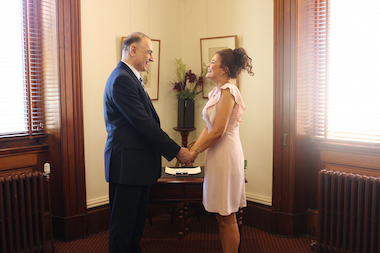
“He said, ‘I’m going to try to organise for you to be admitted to Melbourne Private Hospital within the next 48 hours to check your heart and to see a haematologist’.
“That was the first time the word ‘haematologist’ came up.”
In the meantime, to be allowed into the hospital, George had to have a negative COVID-19 result. The Yiannakis’ returned to the city, and while standing in a long queue to be tested, George got a call from the hospital saying, “we would like you to come in at 6pm tomorrow”, which was a Tuesday.
The next day, George worked as normal before going to the hospital in the afternoon, where he spent the next week.
“The doctors said they’d do whatever tests were necessary to get to the bottom of this which was reassuring. Previously things were left up in the air and I didn’t know what to do.”
Further examination of his heart showed no blockages and three days later, after a thorough physical examination by a haematologist, that’s when George was told he might have amyloidosis and/or myeloma.
“You hear about the more common terms like leukaemia, lymphoma, but for me, this was completely strange terminology, and dare I say, frightening.
“I never imagined it would end up being a form of blood cancer.”
He was referred to a specialist amyloidosis unit at Box Hill Hospital under the guidance of Dr Simon Gibbs. The plan was to transfer him by ambulance, but as no beds were available, George went home and waited for a call from the hospital, which was an hour away by bus.
“I first saw Dr Gibbs at Box Hill on the 27th of September. He said amyloidosis is one of the most rare forms of cancer, that it’s treatable but is a serious condition, and not something to take lightly. And, as one goes through the treatment process, it will have significant effects on one’s lifestyle, work, and family relationships.
“He gave me a comprehensive set of brochures from the Leukaemia Foundation.”
This included an information booklet on amyloidosis which George didn’t want to open.
“Patricia started reading and I said, ‘please read it to yourself, I’m still trying to come to terms with this – the suddenness of it all’. I was overwhelmed by it all,”
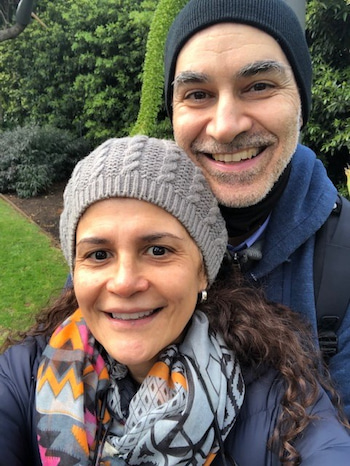
“For me, it’s not just about me… it’s about the impact on Patricia, because we don’t have immediate family here – they’re overseas.”
“You have all these emotions – denial, anger, disappointment – before you walk the path of acceptance.
“For me, it was difficult to internalise and accept because I thought I did everything right lifestyle-wise.
“I asked Dr Gibbs, “what factors could have precipitated this?’ And he said to me, ‘just bad luck’.
“And the reason I felt so sad, was it wasn’t just about me. I knew that this would affect us as a family, my wife and I, because I was the primary salary earner.
“We had to go through this together and there was an awful lot of trauma,” said George.
“Dr Gibbs noticed the diagnosis had taken an emotional toll on me and referred me to a psychologist based at the hospital.
“I had four or five sessions where I expressed my feelings of what I was going through coming to grips with this sudden situation out of the blue.”
Starting AL amyloidosis treatment
Further tests revealed George also had myeloma which he described as “a double whammy”, and in mid-November 2021 he started standard treatment, VCD*.
“I was hospitalised for the first cycle and Patricia had organised for us to move from the city to a suburb next to the hospital which was more convenient, so we didn’t have to travel one hour each way with public transport,” said George.
“The relocation was a lot for her to arrange – to find the removalist, get professional cleaners, and be there for the appointment for the final inspection with the property manager.
“And I just felt so powerless because normally I like to take responsibility for these things.”
“Under normal circumstances I would be able to offer and contribute more, whether it’s grocery shopping, or carrying things. But when you’re so tired and lethargic, all the weight of responsibility falls on your loved ones and the people around you.”
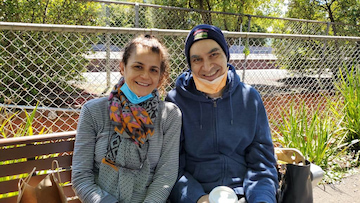
George and Patricia had married in January 2019.
“We had a civil ceremony, but after the diagnosis, I felt it was very important for us to have a church wedding, to be placed in the house of god,” said George.
“In March this year [2022] we got married in our Greek Orthodox Church.”
Patricia, a childcare educator, is now George’s full-time carer.
“At every appointment I’ve had for tests, screens, specialist appointments, she’s always been there. It’s reached a point now where even the security guards at the hospital will ask me, “where’s Patricia today? Isn’t she coming?”
At the end of March 2022, George’s treatment was stopped.
“Unfortunately, I wasn’t getting the response that Dr Gibbs had hoped, with the level of my lambda cells (light chains), which were quite high,” said George.
“The light chains were coming down, but at a very slow rate. At one stage the dosage of some of my medication was increased to see whether it would have a profound effect on reducing the light chains, but unfortunately it didn’t happen.”
MM24 clinical trial – the opportunity and decisions involved
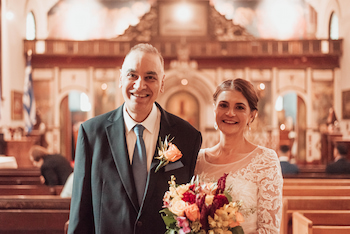
Dr Gibbs revaluated George’s case.
“He said, ‘perhaps we could try to get you on some newer medicine that’s not officially approved by the government but is available through a clinical trial’.”
Two different studies were initially considered but George wasn’t eligible because he also had myeloma.
“Some time later, Dr Gibbs said, ‘there’s a new French clinical trial, MM24. I would like to get you on this George, but the French body has the final say about your acceptance into the trial or not’.”
George was given a 25-page document outlining the trial protocol and treatment side effects and any questions he had were addressed at a follow-up meeting with Dr Gibbs.
“Along with that, we looked at other information that was available about this type of medication, for our own peace of mind.
“Ultimately, it was our decision. It was made very clear to us that this was a new opportunity for me.
“We had to make an informed decision based on what we believed was in our best interest, and we embraced it after collecting this information and having our questions answered,” explained George.
In the meantime, George had to have comprehensive tests – bloods, bone marrow, and a PET scan – to ensure he met the trial requirements, and these had to be done “pretty quickly”.
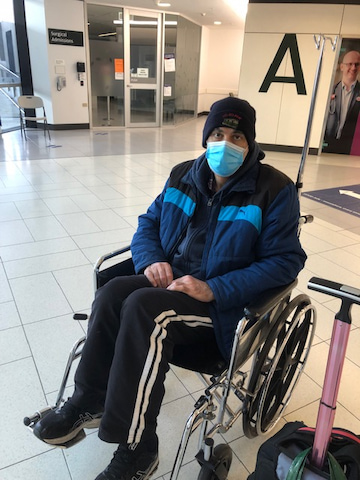
Due to the short notice and normal waiting periods, the PET had to be done at a private hospital. It would not be covered by Medicare or private health insurance and the cost was around $850. Dr Gibbs told George there was no guarantee of what the results would show and whether this would open the door for him to be accepted on the study.
“I thought to myself, ‘well, what other option do I have?”
The PET scan was arranged quickly by a trial assistant from Monash University and the results were sent to Dr Gibbs.
“He called me later to say he was pleased with the results and ‘we’ve more or less cleared the final hurdle to go on the trial’.
When George spoke to Amyloidosis News, he had been on the MM24 trial for six weeks and he was the first patient in Australia to go on the trial which was expected to recruit 48 patients in France and 12 in Australia.
The first day of George’s first treatment cycle was on May 24 – an intravenous injection of isatauximab in combination with two tablets – pomalidomide and dexamethasone. It was a three-week cycle, followed by a week’s break.
“I’m feeling more positive, and even the physical symptoms of this treatment are more moderate, more manageable,” said George.
“I continue my daily physical activity routine. We try to walk a couple of kilometres every day, just to be active, because that’s just as important, to clear my mind.
“After two cycles, my case will be reviewed. If the response is not what is expected, I’ll come off the trial, but if I am getting a positive response then the expectation is that I would continue and complete the full cycle of the treatment,” said George and, according to the trial protocol, that’s between nine and 12 cycles all up.
“And so far, so good.”
After the trial, if George’s light chains have come down “as much as possible”, the potential is that he would go on to have a stem cell transplant.
“I’ve reached a point now where I know that I have to deal with this as best as possible,” said George.
“I need to confront my situation and adversity head on. I know that I’m in the best medical hands. Dr Gibbs and his wonderful team have my best interests at heart and really do want to find a solution and help me get through this.”
George has great support from colleagues and friends
After his diagnosis, George spoke to his manager at work “who was very supportive”.
“All my colleagues were sending me messages. Some were saying, ‘why you George, of all people? You don’t deserve this’.
“One day when I was in the hospital, I received a call from our senior executive with the department, which I never expected, saying ‘we’ll support you as an organisation as best as we can. Hang in there. Keep your spirits up’,” said George.
“I was assigned a case manager who kept in touch and dealt with the administrative side of things because I could no longer work full-time, so they tried to accommodate me as I was going through treatment.
“I’m forever grateful for everything the department has done for me,” said George about the support and understanding he received from people on his team, supervisors, and senior executives.
“They’ve been wonderful all along,” said George who is now back at work six hours a week.
“This is very positive for me from an emotional point of view, but I also feel valued and valuable. It’s not my nature to just stay at home and wait for the next chemo treatment or the next specialist appointment and watch TV. I want to be a productive member of the community, to contribute, and be respected for that.”
George also has a good network of friends “who really show their care and support, which makes a difference”.
And friends overseas, in Europe and South America “show their love and care through messages and phone calls”.
And as a practising Christian, George said members of his church community “come up to us on Sunday, give us a hug, and always say ‘you’re in their prayers’”.
“So many people have told me faith, hope, optimism, and patience are as important as the treatment itself. The emotional or the psychological state of a patient goes hand-in-hand with modern medicine and treatment,” said George.
“I do understand that. Obviously, it’s not possible to be positive and confident all the time.
“Human nature and emotions mean there are days when you still question… where do I go from now? Or, why has this happened to me? But then you try to put all those things in the back of your mind and know, I’m here at this point, what is the best thing that I can do to help my situation?”
George’s advice to others
George said his main piece of advice was “to go by your gut feeling”.
“We know how our bodies work and we know when something’s not right,” he said.
“If you’re feeling that you’re not getting the proper attention, whether it’s in a hospital setting or from your local GP, persevere. Try to get the answers if you are feeling that there are unanswered questions.
“If I hadn’t been knocking on the door and asking those questions and telling them, ‘the blood tests may show this, but I’m still not feeling well. This isn’t me. I know the signs. My body’s telling me otherwise. Think about other tests’.
“Sometimes, hospitals and medical professionals, they’re overwhelmed. They’re stressed. They have so many things on their plate, and it’s easy for a person to fall through a gap.
“And timing is of the essence. I think early diagnosis is so important in giving you the best possible chance to get a good result through the treatments. And even if it means seeing someone else, get a second opinion. That’s my advice.
“Yes, they are respected professionals, but we’re all humans ultimately. And maybe there are things that are overlooked, some indicators that may be passed over and that are important in identifying a condition and making a diagnosis,” said George.
* VCD: bortezomib (Velcade®), cyclophosphamide, and dexamethasone.
Last updated on January 23rd, 2023
Developed by the Leukaemia Foundation in consultation with people living with a blood cancer, Leukaemia Foundation support staff, haematology nursing staff and/or Australian clinical haematologists. This content is provided for information purposes only and we urge you to always seek advice from a registered health care professional for diagnosis, treatment and answers to your medical questions, including the suitability of a particular therapy, service, product or treatment in your circumstances. The Leukaemia Foundation shall not bear any liability for any person relying on the materials contained on this website.